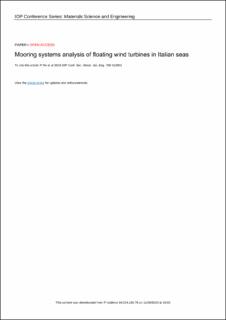| dc.contributor.author | Re, P. | |
| dc.contributor.author | Passoni, G. | |
| dc.contributor.author | Gudmestad, Ove Tobias | |
| dc.date.accessioned | 2023-01-25T14:45:44Z | |
| dc.date.available | 2023-01-25T14:45:44Z | |
| dc.date.created | 2019-12-05T12:42:02Z | |
| dc.date.issued | 2019 | |
| dc.identifier.citation | Re, P., Passoni, G., & Gudmestad, O. T. (2019, November). Mooring systems analysis of floating wind turbines in Italian seas. In IOP Conference Series: Materials Science and Engineering (Vol. 700, No. 1, p. 012002). IOP Publishing. | en_US |
| dc.identifier.issn | 1757-8981 | |
| dc.identifier.uri | https://hdl.handle.net/11250/3046392 | |
| dc.description.abstract | In recent years, interest in exploiting wind power in deep waters has grown, with the realization of floating structures that could accommodate a turbine and produce electricity. One of the many challenges that these projects face is the position keeping of the system in a defined part of the sea: this is carried out with mooring systems, designed to withstand extreme marine conditions. The first aim of this work is to analyze these systems, to find a general solution for a floating wind farm in the Italian seas. Of importance is to suggest a design that could be fabricated in an Italian dry dock and towed to site. A numerical model of the floating structure and the environment has been realized using the software, OrcaFlex, and simulating the 50- and 100-year return period conditions in the Adriatic Sea and in the Strait of Sicily, with different mooring combinations of present-day technologies. The model's implementation requires environmental and structural parameters: the former have been obtained with a statistical analysis of actual recordings of wind speed and wave height and with the official Italian cartography. Structural details have been derived by looking at existing floaters, finding the most suitable one for the Italian environment. After simulations, the results are interpreted with a comparison of tension in the lines, vertical forces at the anchors, wire length and mooring footprint, finding out that depth has the greatest impact on these factors. With respect to this, the proposed numerical model can provide a simple indication for the mooring of floating wind turbines in two different areas of the seas surrounding the Italian peninsula: for the Adriatic Sea (shallow waters), suction anchors with chains should be preferred, while, for the Strait of Sicily (deeper waters), traditional anchors may be considered, with lines composed of chains or a combination of chains with synthetic fibers. | en_US |
| dc.language.iso | eng | en_US |
| dc.publisher | IOP Publishing | en_US |
| dc.rights | Navngivelse 4.0 Internasjonal | * |
| dc.rights.uri | http://creativecommons.org/licenses/by/4.0/deed.no | * |
| dc.title | Mooring systems analysis of floating wind turbines in Italian seas | en_US |
| dc.type | Peer reviewed | en_US |
| dc.type | Journal article | en_US |
| dc.description.version | publishedVersion | en_US |
| dc.rights.holder | The authors | en_US |
| dc.subject.nsi | VDP::Teknologi: 500 | en_US |
| dc.source.pagenumber | 1-13 | en_US |
| dc.source.volume | 700 | en_US |
| dc.source.journal | IOP Conference Series: Materials Science and Engineering | en_US |
| dc.source.issue | 1 | en_US |
| dc.identifier.doi | 10.1088/1757-899X/700/1/012002 | |
| dc.identifier.cristin | 1757117 | |
| cristin.ispublished | true | |
| cristin.fulltext | postprint | |
| cristin.qualitycode | 1 | |

